CONTENTS 1. PREFACE 2. INTRODUCTION 3. PROBLEMS WITH UNBALANCING 4. CAUSES OF INSUFFICIENT UNBALANCING 4.1 Causes with tori 5. SOLUTIONS 5.1 Fault analysis 6. INSTRUCTING KUZUSHI 6.1 Timing 7. EXAMPLES 7.1 O-goshi 8. CONCLUSIONS 9. REFERENCES 10. GLOSSARY 1. PREFACE During my years of Judo-activity, I became increasingly conscious of the important of unbalancing ("kuzushi" in Japanese). After I managed to understand the original principles of Judo in relation to kuzushi, many throwing techniques rapidly became a lot more successful in both randori and shiai. It enabled me to analyze many randori-situations and thus improve my throwing techniques. In more recent years, I have become active in teaching Judo and have discovered that often a strong emphasis on kuzushi can help solve a student's problems with learning throwing techniques. Simultaneously, I developed a vision on this aspect and found methods that proved quite successful for learning or teaching certain throws. This vision is not at all new. It is merely a specific approach to the basic principles of Judo, forcing the student to concentrate on the essential aspects for learning a throw. I think many Judo instructors will recognize this vision. However, I thought it useful to explain this vision in the paper I had to write to conclude the Dutch "Judo instructor B" course in 1994. After many requests for an English version, I started to translate the paper in 1996, resulting in these pages. I assume the reader is familiar with customary Judo terminology and with teaching Judo. In the last section, some terms are explained in a glossary. Some explanations require some sense of spatial imagination regarding throwing techniques Note that although the Judoka in general is referred to as "he" or "him", both male and female Judoka's are addressed with these words. 2. INTRODUCTION Judo is a sport that is performed all over the world. An important aspect with Judo is that executing a typical Judo technique is difficult to learn. Many years of practice are usually required before a Judoka is able to successfully apply a few different throws in competition. Since students enjoy practicing Judo more when discovering the ability to execute certain techniques successfully, speeding up the learning process as much as possible is important. Especially with throwing techniques, the aspect of kuzushi is of major importance. Besides kuzushi, also the elements timing, speed and direction are essential for a successful throw. Therefore, many students experience tachi-waza as more difficult than ne-waza. In ne-waza, one can temporarily forget about timing and speed during practice, thereby facilitating the understanding of the principles of a technique. About a century ago, the founder of Judo Jigoro Kano already pointed out the importance of kuzushi. Without kuzushi, many throwing techniques are impossible and with insufficient kuzushi, performing a throw, if at all possible, will cost much unnecessary effort. In the Judo world, the importance of kuzushi is certainly acknowledged. Teaching throwing techniques usually involves showing how to unbalance uke before performing the throw. However, while being a student in different Judo classes and observing and teaching Judo classes at several clubs, I discovered that problems with throwing techniques very were often caused by neglect of the unbalancing of uke. 3. PROBLEMS WITH UNBALANCING In the average Judo class, several students often struggle with a throwing technique because of insufficient unbalancing of uke. Even Dan-grade holders sometimes exhibit the inability to perform certain throws without uke's "jumping" help. Still, these Judoka's must have been told for years (or at least once) about the importance of kuzushi. From this observation, it can be concluded than many Judo students could be able to perform many throws much better if they could better understand and apply the principles of kuzushi. Two questions emerge: 1) Why is it that so many Judoka still neglect unbalancing so severely? (Causes) 2) How can this problem be solved? (Solutions). Of course, for solving problems first the causes need to be identified. In the following sections, an attempt is made to answer these two questions. Note that the problem typically lies with Judoka, neither being beginners nor Dan-grade holders. The usual profile of a judoka with these problems is a 2nd or 3rd Kyu-grade holder. The problems occur with judoka of all ages. For children younger than about eight years however, to whom the kuzushi principles can only be addressed to a limited extent, the problem is not relevant yet. 4. CAUSES OF INSUFFICIENT UNBALANCING Evidently, for poor kuzushi many causes can be identified. However, in this paper, the major broad outlines are analyzed and a classification is made of various categories of causes. Causes may lie with the instructor, the instruction method, with uke or with the judo student himself. Also, the problem may be caused by years of erroneously rehearsing a throwing (and thus unbalancing) technique or the problem may arise during a particular lesson with learning to perform or improve a particular throw. 4.1 Causes with tori Naturally, this cause is the most frequent one. The problem lies with tori trying to perform the throw. In spite of a correct instruction by the instructor and correct (re)action of uke, tori does not succeed in correctly throwing because of insufficient kuzushi. In this case, solving the problem requires most effort. The Judoka may continue trying himself with now and then a hint from an instructor, but usually only dedicated individual instruction really helps. Often, the Judoka is not really aware of the problem himself. He does not understand the exact nature and cause of the problem and does not see the relation with kuzushi. Therefore, much depends on the ability of the instructor to make the student aware of the critical importance of kuzushi. With better understanding of the problem, the Judoka will be more able to improve it. 4.2 Causes with uke The role of uke is very important. An uke, not willing to fall or not willing to move in the right direction can easily make a throw impossible. Solutions to this problem lie in more attention to uke's action necessary for the throw and specific instruction to uke. 4.3 Causes with the instructor Naturally, an incompetent instructor leads to poor class results. In the long term, this may frustrate Judo students for they are generally not able yet to identify and correct the errors they make (i.e. erroneous or no kuzushi). Many techniques will not succeed in spite of frequent practicing. 4.4 Causes with the instruction method The problem may also have its origin in the generally accepted Judo instruction methodology. For instance, it might be possible that this methodology lacks sufficient emphasis on unbalancing in the instructions for learning and improving throwing techniques. 5. SOLUTIONS 5.1 Fault analysis In can be stated that when practicing a throwing technique, the direct cause of problems with performing the throw lies in faults of either tori or uke or both. In order to identify and solve the problem, the execution of the throw must be analyzed. The identification of particular faults requires fault analysis. In ref.1 (Part 1, section 2.1.2) fault analysis is discussed thoroughly. Fault analysis can best be applied with individual instruction. A Judo instructor, well skilled in fault analysis can easily improve the execution of many throwing techniques. Of course, the instructor then needs to be skillfully familiar with the technique. Often, the execution of the throw must be repeatedly observed and sometimes the instructor needs to act as uke in order to literally "feel" what is going on. If uke acts wrongly, the instructor can discover this by performing the throw with uke. Advanced students may learn (with some help from the instructor) to analyze faults themselves and thereby obtain the ability to rapidly develop there own technique. Noting that also the identification of insufficient kuzushi requires fault analysis is important. 5.2 Individual instruction If the problem is clearly caused by the student himself, individual instruction is the way to go. This often leads to a surprisingly rapid improvement. After involving the student in an analysis of the faults, an example can be presented showing how to unbalance uke correctly. At the same time, how and why kuzushi must be applied can be explained. This also makes it easier for the Judoka not to forget to pay attention to kuzushi. Usually it is very beneficial to exaggerate kuzushi during demonstration and to advise the students to maintain doing so during uchi-komi practice of the throw. This creates an automatic powerful and effective kuzushi for competition and randori. 5.3 Instruction to uke When instructing a throwing technique to a whole class, a first step is to pay attention to the action of uke. This may be done using a typical situation from competition as an example. From the presumed action of uke, creating a condition favorable for the particular throw, a logical conclusion can be presented leading to the decision to use the throw. For many throws, uke's action or posture must meet several conditions, before the throw can be successful. For example, uke can be instructed to move in a particular manner. When uke's action is neglected by the instructor, a lot of frustration can be experienced among the students since they often do not understand when failure of a throw is caused by uke and when caused by themselves.
By frequently involving uke in the explanation of a throwing technique, students will soon learn the importance of uke's action. They will learn to think about when a throw may be successful and when it will likely not be, both for the case where they throw and the case where they are threatened to be thrown. 5.4 The instructor The instructor may in many different ways fail to teach throwing techniques effectively. This paper however only intends to help solve the above-mentioned problems. In case of fundamental shortcomings with the instructor, only the customary instructor courses, such as those organized by Judo Associations, can help. This aspect is therefore considered beyond the scope of this paper. 5.5 Adaptions to the instruction methodology Customary instruction methods as presented by the instructor courses of the Judo Associations like the Dutch Judo Association (JBN) cannot easily be changed. Only after proved benefits, wide acceptation and thorough scrutiny and (international) negotiation, new methods should be included in the instructors course programs. The approach presented in this paper is not aimed at adaption of existing instruction methodology. Only a shift of focus with certain instructions is proposed. Judo instructors have a lot of freedom in deciding what methods to apply and for some, the ideas presented here may prove useful. In the subsequent sections some general directives and examples of how to apply a strong focus on kuzushi are presented using a number of specific throws. 6. INSTRUCTING KUZUSHI In this section several aspects related to kuzushi are addressed. For each aspect, an instruction approach emphasizing kuzushi is explained. Ippon-seoi-nage, a throw that requires strong forward kuzushi will serve as example. Of course, besides unbalancing the student will often have to be pointed to other aspects as well (bending knees/lowering body, lifting using legs, contact of upper bodies etc.). These aspects however, are beyond the scope of this report and it is assumed the student does not make errors except with kuzushi.
6.1 Timing One of the most frequent errors with kuzushi is related to the moment when the student begins with it. The throw often seems to fail due to the lack of kuzushi. After deeper scrutiny however, it often appears that the student very well knows that he must unbalance uke, but he only starts with it after having entered for the throw. After tori has entered for the throw, in many cases (ippon-seoi-nage is a very good example) he cannot apply a powerful kuzushi anymore, simply because he is in a very unfavorable position and posture for it. Therefore, he needs to start unbalancing uke before entry towards the throwing position, resulting in a situation like in figure 2, where uke more or less lies on tori's back. This means that the student learning to improve the throw should be instructed to start unbalancing before everything else (when still facing uke in the neutral judo posture). Uke should easily allow this (see the next section) and then tori can continue to execute the throw. During practice this rule should be exaggerated for many throwing techniques to make sure that later during shiai or randori the Judoka does not try the throw without a reasonable chance of success (or with the chance of being counter-thrown). 6.2 Instructions for uke When practicing a new throwing technique, the student will often want to execute the throw in slow motion. He will want to slowly unbalance uke and keep uke in his unbalanced posture. Due to the slow motion, uke will have to put effort in trying not to fall or change posture. Uke should as much as possible maintain the posture that would have been resulted from a quickly executed throw (like in figure 2). Only then tori can take his time to practice the throw with the appropriate kuzushi. Taking ippon-seoi-nage as an example again, uke must yield when being pulled forwards and keep an upright posture (not crouch or turn away). The latter is a natural defensive reaction that uke must suppress during practice. 6.3 Maintaining kuzushi Another problem that occurs with slow motion execution of a throw is maintaining uke's unbalanced posture. After first having unbalanced uke, tori will start entering for the throw. With many throws he must step and pivot or turn towards uke. During these actions it is difficult to maintain the force necessary for the kuzushi of uke, especially when the student is still in the process of learning the throwing technique. When learning a technique, tori must pay attention to many different things (like how to step when entering) anyhow and also the slow motion execution may well make things difficult. The result from this all is often that tori, during entering for the throw, loosens his unbalancing grip on uke, thereby undoing the effect of all the previous kuzushi. Naturally, the problem may disappear with a more rapid execution of the throw, right after or nearly simultaneously with the kuzushi. Persistently identifying (fault analysis) and pointing at the importance of this problem is very important. The instructor can easily demonstrate the capital difference between maintaining and not maintaining kuzushi. 6.4 Using tori's momentum and gravity Unbalancing uke requires a force being applied on him. Uke's body is moved in a direction until his posture is unbalanced enough to enable easy execution of a particular throw. Tori may both push off with his legs and use his arms to generate the force. However, this way a lot of effort is required. Tori can also generate force using the momentum of his own body. He then first needs to bring his body in motion in the direction of the desired kuzushi. This builds up a momentum equal to the moving mass times the velocity of his body. Due to the inertia of tori's body, the momentum will only change when a force is applied on it. At the instance when the motion is hindered, for instance because of collision with uke or because of tori's limited arm length, part of tori's momentum is transferred to uke's body, resulting in its motion and kuzushi. This sudden transfer of momentum requires a large force during a short period. In the science of dynamics this is called an impulse. When unbalancing using this principle, little effort is needed. It is therefore very suitable for a light weight tori against a heavy uke. For example, it may well be applied with kuzushi in a forward direction with ippon-seoi-nage. In ref.2 and ref.3 the principles of mechanics and dynamics as applied on Judo are thoroughly explained. Depending on the type of students, it is very well possible to include these principles in the instruction of kuzushi during a judo class. Without referring to complex theories of (bio-)mechanics and dynamics, the mechanical principles behind effective kuzushi can be explained. This may very well help to improve Judo skills and understanding of many students. 6.5 Using uke's imbalance and motion Due to the very dynamic nature of Judo "in action", uke's body is often already in motion or in an unbalanced posture. It is evident that from the basic Judo principle of "Ju" (giving way) as one of the means to make maximum efficient use of one's physical energy ("Seiryoku zenyo"), this opportunity must be used, whenever possible. Tori only needs to apply little force or impulse in the direction of uke's motion or imbalance. During entering for the throw, the motion of uke's body must at least be maintained as much as possible. Tori gets help here from the law of inertia again (see section 5.4). During practice, Uke may be instructed to move in a certain direction or assume an imbalanced posture. The instructor can explain this presumption to the students and propose further specific actions by Uke. No need to say that with these exercises throws are "executed in motion". 6.6 Method of entry The footwork when entering for a throw often affects the degree of kuzushi. During the last decade, I noticed that besides the (for right-hand forward throws) customary "stepping towards uke" (pivoting around the left foot, stepping right-left, figure 3), also the method of stepping away from uke (figure 4) is being addressed again. This was especially observed with throws like ippon-seoi-nage and tsuri-komi-goshi.
During an international Judo summer school in Lindow/Mark, Germany 1994 (ref.4), the Japanese instructor Nakanishi demonstrated how he applied his favorite and very successful throw ippon-seoi-nage in competition. He always stepped away from uke when entering, with large steps, pulling uke with him in a forward direction. He often even stepped towards uke first in order to be able to unbalance uke by stepping away from him again. Noteworthy here is that Nakanishi's lessons for the major part consisted of instructions for kuzushi. Of course, stepping away from uke in order to unbalance is nothing new, since it is clearly demonstrated in the nage-no-kata with tsuri-komi-goshi and harai-goshi. However, it appears that many students, when applying this method of entry right from the beginning when learning a throw, better manage to unbalance uke (in common practice however, most students learn to step towards uke when entering for throws like seoi-nage). In a way, it is no surprise that it is easier to step away from uke when unbalancing him, since tori then already moves in the throwing direction during entry, automatically pulling uke towards the right direction and thereby effectively unbalancing him. It is by no means wrong to learn a throw stepping towards uke. Both ways can be very effective. However, it was interesting to notice that many students, once having learned a throw like seoi-nage the former way (stepping towards uke), have many problems learning to unbalance uke while stepping away from him. They have to restrain the habit of stepping "right-left" and change it into "left foot first and then right". 6.7 Uchi-komi Uchi-komi is an important training method rehearsing the actions necessary for a throwing technique. Unfortunately, kuzushi is often neglected during uchi-komi. This is due to the tendency of uchi-komi to degrade to merely an exercise with the objective to enter as many times as possible in a certain period. This may be an effective training method to improve physical condition but if the technique of the throw is neglected, wrong actions are rehearsed which at a later stage are very difficult to unlearn again. The instructor should definitely prevent this. During uchi-komi, kuzushi must remain a full part of the total complex of actions that are repeatedly executed. If this element is ignored, the Judoka is actually exercising the habit to try throwing techniques during shiai or randori without kuzushi. 7. EXAMPLES In this section, the approach presented in the previous sections is demonstrated with a number of examples. The ideas that I bring up here, have emerged during classes in the beginning of my time as instructor, when I discovered that many students experienced significant problems when trying to learn certain throws. First I tried to solve the problem using individual instruction and emphasizing kuzushi. This worked, but only per individual student. Later, I derived training methods, emphasizing the importance of kuzushi at an early stage, in order to be able to apply the approach to the entire class. A number of throws have been selected to which the approach is applicable. These may form the basis for application to other (both forwards and backward) throws. Although interesting for further study, these other throws are not discussed here. 7.1 O-goshi This throw is often one of the first forward throws a beginning Judoka will learn. The focus then is usually on bending the knees and lifting uke using the legs. Although very important, the kuzushi aspect is less critical here since tori's hand on uke's back already automatically pulls uke forwards in most cases. Nevertheless, kuzushi should get attention right from the beginning anyway, because of its importance for many other throws. O-goshi offers a good opportunity to demonstrate how uke should be pulled forwards before entry, in order to execute the throw with minimal effort. In general, the best way to enter for this throw is to step towards uke (right-left) making it easy to put tori's hand on uke's back. 7.2 Ippon-seoi-nage The example throw from section 5, ippon-seoi-nage, is perfect for a demonstration of forward kuzushi, both to beginners and advanced Judoka. The same holds for morote-seoi-nage (figure 5), a similar shoulder throw. Also, the effect of stepping away from uke can be demonstrated perfectly with these throws.
Important for a powerful kuzushi is using ones right hand to pull uke forwards, before it is thrust underneath uke's armpit (assuming a right-hand throw). This arm often remains unused for kuzushi but the habit to use it could very well be trained with uchi-komi. When entering with stepping towards uke (right-left), tori must avoid getting too close to uke. Tori must always feel an inclination forwards rather than backwards, otherwise he can too easily be pulled backwards or counter-thrown by uke. A student must remember always to pull uke towards himself instead of pulling himself towards uke. 7.3 Tsuri-komi-goshi This throw requires about the same kuzushi as ippon-seoi-nage. However, the entering will be more difficult for beginners since tori has to bend his knees and lower his body severely without releasing the kuzushi. As for entering, both stepping towards uke and away from uke (like in nage-no-kata) is possible. 7.4 Tai-otoshi Usually this throw is taught only to at least a little advanced students. More than with other throws, a number of conditions with respect to kuzushi, position, posture and motion of uke, have to be met. For a right-hand tai-otoshi, uke should be forced entirely to stand on his right leg in order to prevent his escape by simply stepping over tori's blocking leg (with his right leg, standing on his left). Without a thorough kuzushi the execution of the throw is nearly impossible. After having entered for the throw, tori is hardly able to pull uke forwards anymore. Therefore, the kuzushi must have been completed at a very early stage (i.e. before entering). When learning tai-otoshi, it may be recommended to first pull uke forwards and to his right in order to have him stand on his right leg. This form of kuzushi can easily be demonstrated slowly. Subsequently, tori must maintain this kuzushi during entry for the throw. If this works, tori can execute the throw without much effort by pushing with his right arm and still pulling with his left. Once the student feels how effortless tai-otoshi can be executed this way, he has comprehended much of the essence of the throw. Of course, during practice uke must allow being pulled onto his right leg. This is easiest if uke stands with his right leg forward. 7.5 O-soto-gari The subject addressed in this paper is mainly related to forward throwing techniques. However, a number of principles are also applicable to other types of throws. A good example is o-soto-gari, a technique to throw uke backward. With this throw also, tori must unbalance uke at an early stage, otherwise he will get into a backward posture himself and be prone to counter-throws. The difference is that the kuzushi with o-soto-gari happens during entry. Tori steps (with one big step) with his left foot outside uke's right foot and while doing this he pushes uke backwards-sidewards onto his right leg. For the rest, the same principles as for forward throws can be applied: also with o-soto-gari an already backwards unbalanced posture or motion of uke can very efficiently be exploited. Furthermore, also here kuzushi needs to be maintained during entry and tori's momentum can very well be used. 8. CONCLUSIONS After observation of the learning processes of throwing techniques during judo classes I attended myself, giving personal instructions and teaching various classes I came to the conclusion that the emphasis on kuzushi is very important. It recurrently appears that students neglect kuzushi if it is not addressed frequently during classes. I still see this happen regularly in some classes and I noticed it frustrates a significant number of students. It is therefore essential that the instructor emphasizes kuzushi during presentation of a throwing technique. I believe that with personal instruction, an instructor quickly and efficiently can explain the principle of kuzushi to a student. This will rapidly develop a student's skills with specific throws. A major factor in this is that personal instruction enables a thorough fault analysis. Emphasizing the importance of starting kuzushi before entry for the throw is very effective when teaching most throwing techniques, especially with beginning students. An additional advantage of this approach is that the student will acknowledge the importance of kuzushi right from the start. Uke's role is very important. In order to allow tori to practice kuzushi, he may not resist it. Uke must avoid pushing or pulling in opposite directions, crouching or turning away. Therefore, the instructor must also give instructions to uke. Maintaining kuzushi, using the momentum of one's own body weight and the unbalance and motion of uke, are aspects to which students must be pointed in order to learn to use kuzushi effectively. Kuzushi is affected by the method of entry for a throw. Stepping towards or away from uke makes a lot of difference for a number of forward throws. It is recommended to point out the importance of this. When learning a throw, the easiest way should be applied. During uchi-komi, kuzushi must remain a full part of the total action being rehearsed. If this is neglected, the Judoka trains the habit to try to execute throws without kuzushi during randori and shiai. In general, it can be concluded than the aspect of kuzushi is essential in the process of learning judo. A clear explanation of kuzushi as a crucial requirement for the success of a throw leads to quick results with judo students. A continuing emphasis on kuzushi, both with instruction and with correction (fault analysis) enhances the ability of students to improve their skills and consequently enhances self-confidence and satisfaction with learning judo. As a result, many Judoka's will, at a much earlier stage, be able to contemplate on kuzushi themselves and correct and improve themselves. In a more extensive study, it would be of interest to analyze all basic throwing techniques in detail according to the approach presented here. 9. REFERENCES
10. GLOSSARY Ju Giving way Kuzushi The unbalancing of the opponent Randori Free practice Shiai Contest Seiryoku zenyo The maximum efficient use of physical and mental energy Tori The player who performs the throw Uchi-komi Repetitive exercise of entering for a throw Uke The player who gets thrown |

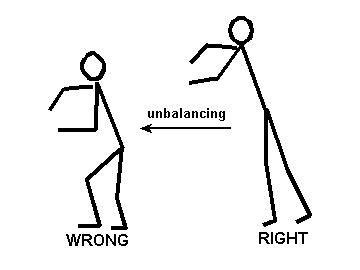 Figure 1 uke's posture after forward unbalancing; right and wrong.
Figure 1 uke's posture after forward unbalancing; right and wrong.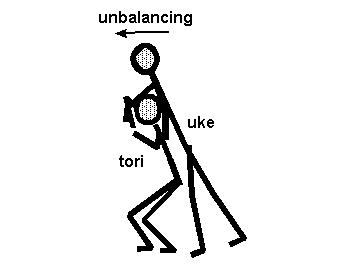 Figure 2 uke's posture after correct unbalancing with ippon-seoi-nage
Figure 2 uke's posture after correct unbalancing with ippon-seoi-nage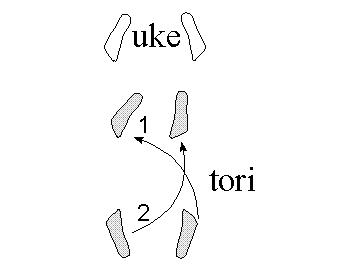 Figure 3 Stepping towards uke ("right-left")
Figure 3 Stepping towards uke ("right-left")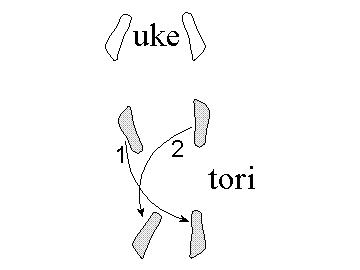 Figure 4 Stepping away from uke ("left-right")
Figure 4 Stepping away from uke ("left-right")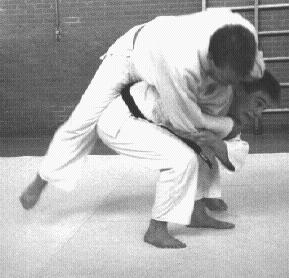 Figure 5 Seoi-nage after powerful kuzushi
Figure 5 Seoi-nage after powerful kuzushi